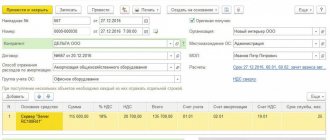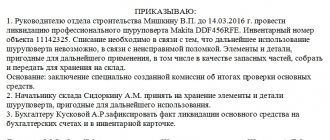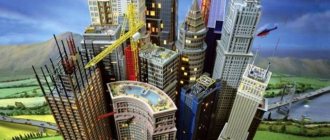What is depreciation?
Depreciation is the process of periodically transferring the initial cost of a fixed asset or intangible asset to manufacturing, selling, or general expenses, depending on how the asset is used.
There are several methods of depreciation, but legal entities using the simplified tax system should probably choose the simplest one - the linear method of depreciation.
The straight-line method is that over the entire useful life of a fixed asset or intangible asset, it is written off in equal shares. Depreciation is charged monthly, starting from the next month after the property is put into operation, and until the original cost of the fixed asset or intangible asset is fully amortized.
OKOF: code 330.28.29
330.28.29 — Other general purpose machinery and equipment, not included in other groups
Classifier: OKOF OK 013-2014 Code: 330.28.29 Name: Other general purpose machinery and equipment, not included in other groups Subsidiary elements: 0 Depreciation groups: 4 Straight adapter keys: 143
Grouping 330.28.29 in OKOF is final and does not contain subgroups.
In the classification of fixed assets included in depreciation groups, code 330.28.29 is listed in the following groups:
| Group | Subgroup | Deadlines | Note |
| First group | cars and equipment | all short-lived property with a useful life from 1 year to 2 years inclusive | tools for metalworking and woodworking machines; diesel engines and diesel generators with a cylinder diameter over 160 mm (diesel and drilling diesel generators) |
| Third group | cars and equipment | property with a useful life of over 3 years up to 5 years inclusive | diesel and diesel generators with a cylinder diameter over 120 - 160 mm inclusive (diesel and drilling diesel generators); household appliances |
| Fourth group | cars and equipment | property with a useful life of over 5 years up to 7 years inclusive | electric motors for electric drilling rigs; crane electric motors |
| Fifth group | cars and equipment | property with a useful life of over 7 years up to 10 years inclusive | internal combustion engines, except engines for vehicles; AC electric motors with a power of 0.25 kW and above (except for special power and large-sized ones); special power electric motors; except for fixed assets included in other groups |
To move from the old OKOF to the new OKOF, use a direct transition key:
Source
How can we calculate depreciation?
As you can see from the formula, you will need to determine the original cost and useful life to calculate the monthly depreciation amount. If there are no problems with the amount of the initial cost, then determining the period of use is sometimes a difficult task.
Do accounting in Elba
Accounting with Elba is easy!
Submit reports without accounting knowledge
Elba will prepare accounting reports for the LLC.
The service is simple: you don't need to know the wiring. Tax reports and reports for employees will also be generated automatically. Try 30 days free Gift for new entrepreneurs A year on “Premium” for individual entrepreneurs under 3 months
High pressure washer shock absorber group
330.30.99.10 - Other transport vehicles and equipment, not included in other groups
330.30.99.10 - introduced by Amendment No. 1/2015 OKOF, approved by Order of Rosstandart dated December 25, 2015 No. 2202-st.
Classifier: OKOF OK 013-2014 Code: 330.30.99.10 Name: Other transport vehicles and equipment, not included in other groups Subsidiary elements: 0 Depreciation groups: 1 Direct transition keys: 38
Grouping 330.30.99.10 in OKOF is final and does not contain subgroups.
In the classification of fixed assets included in depreciation groups, code 330.30.99.10 is listed in the following groups:
| Group | Subgroup | Deadlines | Note |
| Fourth group | cars and equipment | property with a useful life of over 5 years up to 7 years inclusive | garage and gas station equipment |
To move from the old OKOF to the new OKOF, use a direct transition key:
| Classifier | Code | Decoding | Number of child codes |
| OKOF | 330.28.2 | Other general purpose machinery and equipment | 17 |
Code 330.28.2 is included in the classification of fixed assets:
| Group | Chapter | Depreciation periods | Note |
| Fifth group | cars and equipment | property with a useful life of over 7 years up to 10 years inclusive | air separation and rare gas installations |
The entry in the classifier with code 330.28.2 contains 17 clarifying (child) codes.
| 330.28.21 | Chambers, furnaces and furnace burners |
| 330.28.21.1 | Chambers and furnace burners |
| 330.28.22.1 | Lifting and transport equipment |
| 330.28.23 | Office machines and equipment, excluding computers and peripheral equipment |
| 330.28.23.1 | Writing machines, word processing devices, calculators and adding machines |
| 330.28.23.2 | Office equipment |
| 330.28.25 | Industrial refrigeration and ventilation equipment |
| 330.28.25.1 | Heat exchangers; industrial equipment for air conditioning, refrigeration and freezing equipment |
| 330.28.25.2 | Fans other than table, floor, wall, window, ceiling or roof fans |
| 330.28.25.20 | Fans other than table, floor, wall, window, ceiling or roof fans |
| 330.28.29 | Other general purpose machinery and equipment, not included in other groups |
| 330.28.29.1 | Gas generators, distillation and filtration apparatus |
| 330.28.29.2 | Equipment for washing, filling, capping or packaging bottles or other containers; fire extinguishers, sprayers, steam or sandblasters; gaskets |
| 330.28.29.3 | Equipment for weighing and dosing, industrial, household, etc. |
| 330.28.29.50 | Industrial dishwashers |
| 330.28.29.60 | Installations for processing materials using processes involving changes in temperature, not elsewhere classified |
| 330.28.29.70 | Non-electric equipment and tools for soft and hard soldering or welding, and parts thereof; machines and apparatus for thermal spraying |
Hierarchy diagram in the OKOF classifier for code 330.28.2:
The organization's fixed assets, depending on their useful life, belong to one or another depreciation group for profit tax purposes (Clause 1, Article 258 of the Tax Code of the Russian Federation). The useful life of the asset is determined by the organization itself, taking into account the special classification approved by the Government of the Russian Federation.
Determining the useful life
For an intangible asset, the useful life is determined by the company itself. This is the period during which the intangible asset will be used and thereby generate income.
For fixed assets in accounting, an enterprise can also set the period of use independently, but it would not be amiss to coordinate this period with already developed standards and classifiers.
Therefore, to determine the useful life, we recommend using the classifier of fixed assets by depreciation groups, approved by Government Decree No. 1 of 01.01.2002.
If a fixed asset belongs to several depreciation groups, we recommend choosing a useful life from the range of the groups to which it belongs, based on the expected service life of the fixed asset.
Thus, it will be possible to obtain the monthly depreciation amount.
If it is necessary to determine the amount of depreciation for a period, for example, as of 01/01/2019, then you should first determine the date of commissioning, and then calculate how many monthly depreciation amounts should have been made. Thus, the monthly depreciation amount can be multiplied by the number of months from the date of commissioning.
Funds depending on their purpose
According to the function that property funds perform, they can be divided into two large independent groups:
- production assets: those that are used and/or created in the process of the enterprise’s activities;
- non-productive assets : those that help serve production without directly affecting the quantity of product produced.
Funds related to production are reproduced through additional capital investments, just like non-production ones. The main difference between these types of property assets is that the former are directly related to the enterprise’s products, while the latter affect it only indirectly, influencing the work culture of employees.
Groups of production assets
For convenience, production fixed assets, which can be classified as material
- Building (except for those intended for housing):
- garages;
offices;
- workshops;
- housings;
- warehouses;
- hangars;
- outbuildings, etc.
- Buildings, structures - what is necessary for production:
- bridges;
- paths;
- overpasses;
- fencing;
- forests;
- roads, etc.
- Communication means – provide the transfer function:
- communication lines;
- overpasses;
- pipelines;
- heating networks;
- power lines, etc.
- cars and equipment:
- all kinds of devices;
- any units;
- engines;
- measuring technology;
- analyzing instruments;
- laboratory equipment;
- Computer Engineering.
- Tools – all intended for use for more than 1 year:
- devices;
- work supplies;
- household equipment.
- Transport – all forms and types of vehicles, including those used for internal movement in production:
- road transport owned by the company;
- railway rolling stock;
- water vehicles;
- punishments;
- trolleys;
- trolleys;
- loaders, etc.
- Livestock – working and breeding. The composition of fixed assets does not include the cost of feed, young animals and livestock intended for slaughter, since these funds are used for less than a year, and therefore belong to working capital, not fixed assets.
- Perennial plantings:
- parks;
- orchards;
- forest protection strips;
- berry plantations, etc.
- Plots of land are real estate owned by the organization.
Their cost as an operating system includes not only the construction component, but also the costs of communications (ventilation, heating, water supply, gas pipeline, etc.).
IMPORTANT ! In each economic sector, these groups have their own specifications: for example, in agriculture, the composition of fixed assets for the same groups may differ significantly from industrial.
Rationale
The 1st depreciation group of fixed assets (Classification of fixed assets included in depreciation groups) includes:
Condensate, feed and sand, soil, slurry pumps - Code OKOF 330.28.13.1 (Pumps for pumping liquids; liquid lifters)
Mobile air compressors on wheeled chassis - Code OKOF 330.28.13.24
Other compressors - Code OKOF 330.28.13.28
The 2nd depreciation group of fixed assets (Classification of fixed assets included in depreciation groups) includes:
Artesian and submersible pumps - Code OKOF 330.28.13.1 (Pumps for pumping liquids; liquid lifters).
The 3rd depreciation group of fixed assets (Classification of fixed assets included in depreciation groups) includes:
Other pumps and compressors - OKOF code 330.28.13
The 4th depreciation group of fixed assets (Classification of fixed assets included in depreciation groups) includes:
Bitumen pumps - code OKOF 330.28.92.12.190 (Other tunneling machines)
Categories:




